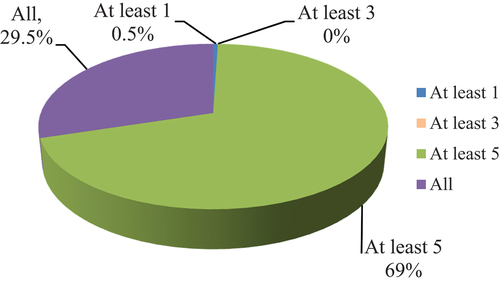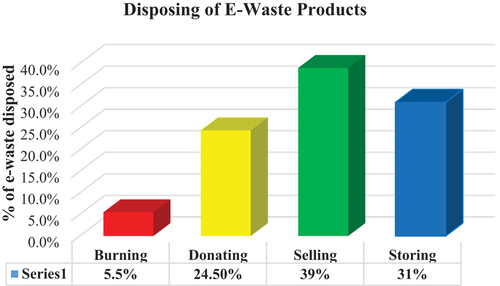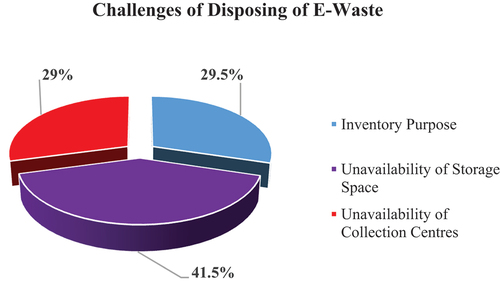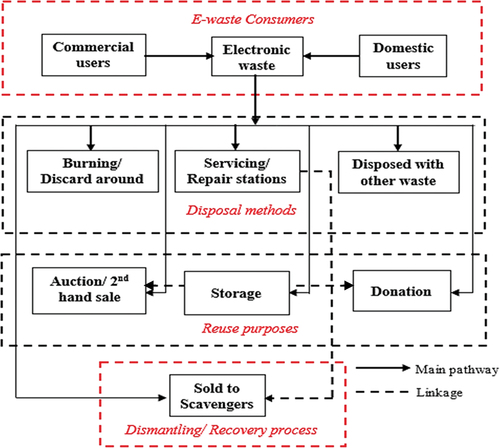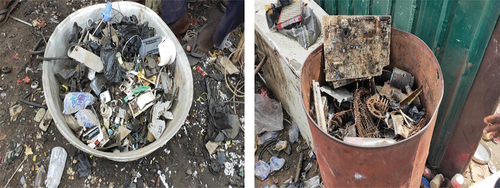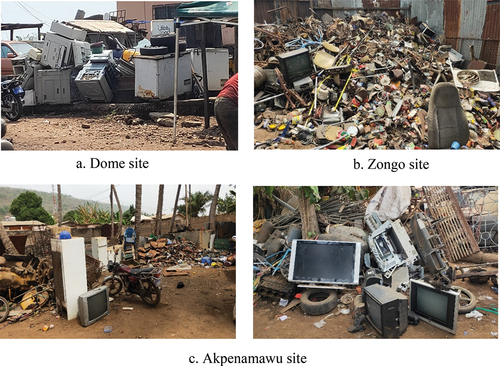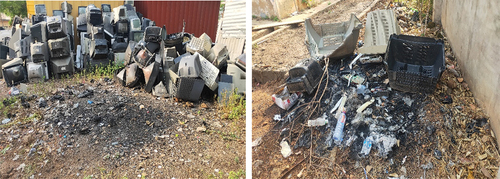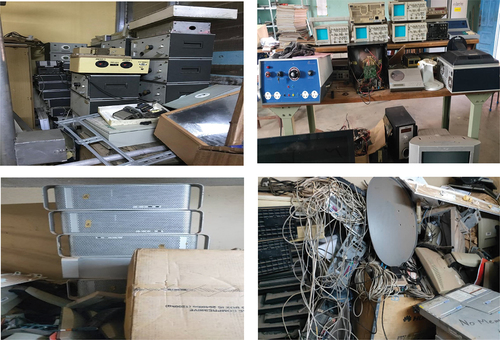 ?Mathematical formulae have been encoded as MathML and are displayed in this HTML version using MathJax in order to improve their display. Uncheck the box to turn MathJax off. This feature requires Javascript. Click on a formula to zoom.
?Mathematical formulae have been encoded as MathML and are displayed in this HTML version using MathJax in order to improve their display. Uncheck the box to turn MathJax off. This feature requires Javascript. Click on a formula to zoom.ABSTRACT
Attitudes and behaviours towards e-waste management among commercial consumers in Ho Municipal, the capital city of the Volta Region, Ghana, will become detrimental to humans and the environment at large. This research aims to examine the perception and practices of e-waste among commercial consumers in the capital city of the Volta Region of Ghana and to document the overall characteristics of e-waste management to help raise awareness about the growing e-waste threats to the environment and to engender discussions to find a lasting solution to the issues. A cross-sectional study was conducted in the Ho municipality during May and June of 2021. The purposive sampling approach was used to select 200 participants from institutions/organisations. Data was collected using a standardized questionnaire, which was then entered and analysed using the Statistical Package for Social Science (SPSS) version 16. The significance of relationships was determined using binary logistic regression analysis with <0.05 p-value and the adjusted odds ratio (AOR) with a 95% confidence interval (CI), and Likert scale analysis with mean response values. Among the 200 participants, there is a high level of knowledge of e-waste and its negative impact on commercial consumers, but there was a low level of awareness of laws and government regulations. The participants’ knowledge of the awareness of e-waste was significantly related to their qualification; 2.472 (95% CI: 1.476–4.142), p = 0.001(<0.05). Moreover, most respondents were aware of toxic/hazardous compounds in e-waste materials, yet they ranked the environmental effect of e-waste as minimal and exhibited poor practices for disposing of their e-waste. We recommend that the existing legislation passed by the parliament of Ghana should be made known and available to the public through continuous televised programs on national television to educate the general public on e-waste management practices due to the lack of awareness and practices in e-waste management.
1. Introduction
In recent times, there has been an increase in the importation of waste electrical and electronic equipment in Ghana which calls for awareness in the disposal of e-waste to reduce harmful effects on human health and the environment. E-waste is created when electronic appliances or equipment become outdated, inoperable, or even damaged. Grey product waste is more toxic than white and brown product waste. This type of trash presents a significant challenge in terms of disposal and recycling in both industrialized and developing nations (Oteng-Ababio, Citation2012).
E-waste is a term that refers to old, end-of-life electronic and electrical (EE) equipment, as well as waste produced by any equipment that uses electricity or a battery, such as EE laboratory equipment, personal computers and laptops, televisions, MP3 players, and other equipment that have been discarded by their owners (Kumar, Citation2015).
Ghana now imports 40,000 tons of electronic garbage per year and has the continent’s largest recycling sector. Several populations in the receiving area have been evicted as a result of the garbage influx, which has major health concerns. Communities like Agbogbloshie in the capital city are dealing with electronic waste and potentially radioactive trash with little knowledge and official apathy. They are the victims of the negative externalities that come with the electrical industry’s boom (Fleischer, Citation2018).
There is a global increase in e-waste and the latest technology issues caused by advancements in technology and industrial development, an increase in population, and economic growth (Needhidasan et al., Citation2014), (Bhutta et al., Citation2011), while the life cycle of these electronic products depreciates so quickly, making them one of the most dangerous waste products produced in our current time.
More research shows that e-waste poses a number of substantial difficulties to city experts in third world countries as the majority of them need a present-day foundation for managing the environment (Oteng-Ababio, Citation2014). Most developed nations use more electronic equipment than the developing nations, which generate more e-waste in their countries, yet there are proper e-waste management systems in place with specific regulations regarding electronic waste management in these developed nations (Raharjo & Utomo, Citation2021)
According to the authors in (Brigden et al., Citation2008), the general public is “unwittingly” making its harmful tracks. Ghana is an importer of most electronic devices with spelled out regulations to manage electronic waste, yet has no obligation to manage its electronic waste. Electronic waste disposal is a very difficult action and involves better expertise, understanding and awareness of the general public about its harmful effects. The poisonous substances from e-waste are the main source of environmental pollution and can lurk in health (Kumar & Singh, Citation2014). If managers of electronic waste pay no attention to the management of the environment, it will cause uncontrolled contamination of substantial metals and poisonous mixtures that are dangerous to our environment (Wahyono et al., Citation2013).
In Ghana to date, the strategies or clear-cut policies for the removal of e-waste are not distinct. This has constrained e-waste generators to form their practices, which in the best-case scenario may not be harmless to the ecosystem, socially OK, or financially practical (E. Owusu-Sekyere et al., Citation2018). Therefore, this paper assesses the perceptions and practices of e-waste management among commercial users in Ho, the capital of the Volta Region of Ghana. This study contributes to the various research documentations of the overall characteristics of e-waste management strategies in the capital cities in Ghana to aid raise awareness about the growing e-waste threat, and support serious discussions about the issues to find a lasting solution through advanced policy implementation strategies.
2. Literature review
The researcher in (Oteng-Ababio, Citation2012) presented an article that checks out the degree of e-waste trade in Ghana by dissecting the developing trade of electronic equipment “to bridge the digital divide”. It additionally looks at its present management practices. The objective was to assist with bringing issues to light about the development of e-waste hazards and empower basic discussion around the issues and ideally, empower further activities. The discoveries showed that e-waste has additionally arisen and is difficult for local authorities to manage as far as its management at the end of use is presently driven by the informal sector.
In (E. Owusu-Sekyere et al., Citation2018), the authors explored the dynamics of e-waste disposal strategies in Tamale, Ghana. This research examined some of these disposal approaches and the factors that influenced their adoption in Tamale, a growing city in northern Ghana. The data for the study were sampled using diverse methods including a questionnaire survey and key informant interviews. The major disposal approaches that emerged were selling e-waste to scrap dealers and donating. The respondents’ age, education level, and income were influenced by these adopted management strategies.
The author in (Jadhav, Citation2013) noted that e-waste management will provide successful procurement and assortment through material disposal, ensuring e-waste becomes a profitable business opportunity. The complete manufacturing of products and their sustainable management is the responsibility of policymakers. The important factors in designing a product that meets good environmental practices and can speed up recycling are raw material selection, product, and process design. Furthermore, proper management and e-waste disposal practices need to be considered.
Electronic waste and its negative impact on human health and the environment were reviewed by writers in (Moletsane & Venter, Citation2018). They investigated the harmful impacts of poisonous metals from e-waste on human health, animals, and the environment. According to the data, there is no one ideal technique for eradicating e-waste and related issues. The inappropriate management of e-waste is caused by a lack of appropriate education, which results in low levels of awareness. As a result of this research, the most essential factors influencing appropriate and correct e-waste management, i.e. excellent (“green”) information technology practices, are awareness and adequate education.
The handling of electronic waste in India was evaluated by researchers in (Sahu, Citation2019). The article attempted to compile information on the current state of e-waste generation, data on the components and hazardous substances in e-waste that are polluting the environment and causing human exposure to these chemicals, as well as the negative consequences of e-waste recycling, incineration, and landfill disposal. It was discovered that India’s existing e-waste management processes had a variety of drawbacks, including insufficient laws, inventory challenges, health risks from informal recycling, lack of knowledge, and corporate reluctance to address crucial concerns.
Again, in (Maphosa et al., Citation2020), a comprehensive e-waste management assessment was done in the study area. About 80% of the assessments were done in Ghana, Nigeria, and South Africa. Proper evaluation of the research performed shows that the primary impediments to efficient e-waste management are the lack of legislation and poor recycling infrastructure.
The authors in (Rautela et al., Citation2021) investigated e-waste management and its impacts on the environment and human health. The paper provides a thorough evaluation of initiatives to address the issue of inadequate e-waste recycling processes and their hazardous effects on human health and the environment. They concluded that adequate control of e-waste requires an inventory of end-of-life electronic items, which may be established through the construction of an environmentally acceptable regulatory system for recycling.
The analytic hierarchy process technique was used in (Alblooshi et al., Citation2022) to analyse and rank e-waste processing system choices in the United Arab Emirates. The collected findings show that recycling is the most important option in the e-waste processing system among the options investigated. Due to stakeholders’ poor economic and environmental awareness of e-waste, e-waste management system actions must be accelerated in order to comply with best practices developed nationally and globally.
Researchers in (Hamdan & Saidan, Citation2020) acquired, analysed, and quantified data on e-waste generation and disposal techniques in 15,883 homes using ArcGIS mapping. According to the study’s extrapolated findings, 8,735,187 e-waste products (13 ktons) were converted to e-waste and disposed of by all homes in Jordan’s 12 governorates in 2018. Furthermore, dumping e-waste is still the most common method of disposal for 58.4% of Jordanian households. Other disposal strategies revealed that donating to others has a 16.6% share, selling has a 10.7% share, and providing waste EEE for ecologically sound recycling has a 6.8% share.
The authors in (Andeobu, Wibowo, Grandhi et al., Citation2021a) critically examined past studies on e-waste creation and management techniques in Asia Pacific countries, providing an overview of the progress made and identifying areas for improvement. Previous studies from 2005 to 2020 were gathered from multiple databases to meet the goals of this study. This study discovered that the chosen nations’ e-waste management procedures need to be improved, and it suggests numerous best practices for properly managing e-waste.
The authors in (Andeobu, Wibowo, Grandhi et al., Citation2021b) also provided a critical review of previous research on e-waste generation and management practices in several countries, including Canada, France, the United States, the United Kingdom, Nigeria, and South Africa, as well as an overview of progress made and areas for improvement. The research looked at things like e-waste creation, e-waste recycling, e-waste disposal techniques and behaviour, e-waste environmental management, e-waste concerns and difficulties, and e-waste legislation. The study provided general best-practice methods to e-waste production and environmental management taking into consideration country-specific challenges and recommends future research opportunities based on the findings of the analysis of the current situation of the selected countries in the literature.
The relevance of e-waste management methods for environmental sustainability is highlighted in reference (Mor et al., Citation2021), which investigates people’s empirical studies done in India using a well-structured questionnaire distributed among engineering students. In educational institutions, six essential levels of knowledge concerning e-waste management, generation, and initial treatment procedures were investigated. The findings of this survey found that there is a lack of understanding about e-waste creation and processing procedures, although the extended producer responsibility idea is gaining traction. Despite the efforts of competent authorities, only a tiny percentage of the populace is aware of e-waste management.
Finally, utilizing two alternative methodologies, the authors in (K. Owusu-Sekyere et al., Citation2022) suggested the material flow analysis (MFA) methodology as a technique of data collection within a short period in the informal e-waste recycling environment at Agbogbloshie, Ghana. To validate the data collected, the mass and material flow of e-waste treatment processes on site were observed and documented in two ways. First, the kind, measures, composition of load, and several loaded vehicles entering and exiting were observed and documented. Second, to validate the data collected, the mass and material flow of e-waste treatment processes on site were observed and documented. The resulting yearly mass fluxes of e-waste range from 13,090 to 17,094 t/a. According to statistics from the Global E-waste Monitor for Ghana, Agbogbloshie treats an average of 15,092 t/a (about 39% of Ghana’s e-waste creation).
There has so far been no exhaustive data provided by research on e-waste management practices by commercial consumers, the available infrastructure for e-waste disposal, and e-waste awareness in Ho, which is the capital city of the Volta region and the home of major commercial activities in the region. It has therefore become imperative to conduct this study to provide the comprehensive data necessary to inform decisions about ameliorating the dreadful impact of improper e-waste disposal practices.
3. Research methodology
3.1 Study area
Ho, the capital city of the Volta Region, has been chosen for this study. The study comprehensively looks at the survey on commercial electronic waste management by selected cooperating institutions such as government ministries, banks, schools, hospitals, hotels, guest houses, etc. The choice of the selected institutions in Ho Municipality was made because of their proximity to the researchers. The choice of the selected institutions was based on the number of electronic and electrical gadgets they employ in their operations, the sector type, and last but not least, their proximity to the researchers in the Ho municipality.
The city of Ho as shown in is located between latitudes 6° 20 1 N and 60° 55 1 N, and longitudes 0° 12 1E and 0° 53 1E, with a total area of 11.65 km2. Temperatures in the major cities range from 22 to 32 degrees Celsius, with yearly mean temperatures ranging from 16.5 to 37.8 degrees Celsius. Ho is the administrative and commercial centre of the Volta Region and is one of the twelve districts of the Volta Region (Abankwa et al., Citation2009), with a population of 180,420 people as projected by the 2020 population and housing census (Ho Municipal (Municipal District, Ghana), Citation2022). Infrastructure, environmental management, social services, financial management, and institutional capabilities are among the city’s development requirements and investment prospects.
Figure 1. Map showing Ho Municipal Area (Ho—Google Maps, Citation2021).
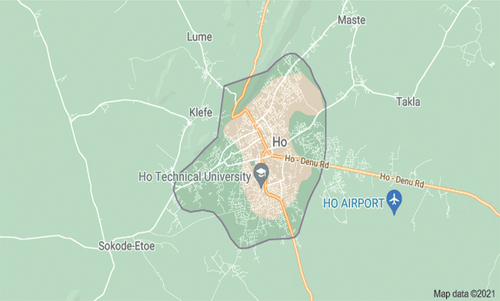
3.2 Determination of sample size
The normal approximation to the hypergeometric distribution formula was utilized to compute the sample size for small populations, as illustrated in Equationequation (1(1)
(1) ; Morris, Citation2014), where the small population represents the selected institution/organization situated within Ho Municipality, with the following assumptions:
Where;
N→(population size consisting of selected institutions/organizations = 245); pq→(estimated proportion of success and failure assumed to be 50% since there was no previous study at the time of this study); E→(margin of error = 3%) and Z→ (standard score value for 95% confidence level = 1.96), the minimum sample size (n) was 200.
3.3 Data collection and instrument design
To examine the perceptions and practices of commercial electronic waste management, several corporate institutions were purposively selected. Investigators used a pre-tested, structured interviewer-administered questionnaire that was devised after evaluating a lot of literature (Kabito et al., Citation2021). The questionnaire was divided into four sections and was mostly closed-ended. The first section of the questionnaire asked for basic biographical data such as age, gender, educational level and experience at the workplace. The second section looked at general e-waste awareness and its harmful effect (Yes/No), awareness of laws and government legislation and the overall setting and condition of e-waste storage (Good/Bad). The third section examined respondents’ attitudes about e-waste disposal practices and the issues that come with them, while the fourth section examined respondents’ perception of the impact of e-waste on the environment, using a four-point Likert scale to gauge perceptions (4 = very strong; 3 = strong; 2 = fairly and 1 = no effect).
Respondents were selected via a purposive sampling method in administering the questionnaires. This suitable technique was employed to ensure that heads of the various cooperate institutions were fairly represented and included in the study. When more than one qualified respondent was located in the designated office, the lottery technique was utilized to pick a responder. The data collectors went to all of the systematically chosen institutions/organizations and interviewed the heads or any other office members above the age of 20 (Kabito et al., Citation2021).
Two hundred (200) respondents participated in this research survey, which was conducted in May and June 2021. The questionnaire replies were scrutinized for mistakes, inaccuracies, and contradictions. Questionnaires were given, identification numbers and responses were coded, and data processing was performed using Statistical Package for Social Sciences (SPSS) version 16 to process the collected data. Binary logistic regression, Likert scale analysis and descriptive statistics were the analytical tools employed.
4. Results
An assessment of the perceptions and practices of commercial e-waste management was conducted in selected corporate institutions in Ho Municipality, Ghana. Bio-data, awareness of commercial e-waste disposal practices, and challenges were questions answered by the participants to the questionnaire and their results were presented.
4.1 Biographic data of respondents
Table shows the gender, age, and educational background of the respondents. In the study, 49% of the respondents were male, and the rest (51%) were female. In addition, 18%, 29%, 41%, and 12% of the subjects were 20–30, 31–40, 41–50, and >50 years old, respectively. The study further revealed that 11.5% were certificate holders from the Senior High School (SHS) while 15% had a diploma. About 69% had their formal education to the tertiary level with a bachelor’s degree, whereas only 4.5% had a master’s certificate. Finally, Table demonstrates that the majority of respondents had between 2 and 10 years of experience. This indicates that they have sufficient expertise to respond to the study questions.
Table 1. Demographic characteristics of respondents
4.2 Awareness of E-waste
4.2.1 Awareness level of E-waste, health risk, laws and government legislation
Respondents expressed their knowledge of the awareness of the existence of e-waste. The data was analysed using binary logistic regression, and the results are summarized in Table . The chosen predictors model for the outcome of this analysis are “Gender, Age, Qualification and Experience”.
Table 2. Awareness level of e-waste
a. Variable(s) entered on step 1: Gender, Age, Qualification, and Experience
From the results obtained, the model was statistically significant (X2(4) = 14.913, p < 0.05) from the test of model coefficient (Chi-square). According to the Nagelkerke R2, the selected predictors account for 13.3% of the difference in awareness level. Further analysis predicted that females were 1.70 more aware of the existence of e-waste than males. Qualification was associated with the likelihood of being aware of e-waste. The predictor’s odds ratio (OR) is 2.472 (95% (CI):1.476–4.142), p = 0.001(<0.05), indicating that qualification as a predictor is significant at the 5% level. The model predicted that 3.8% of participants were not aware of the existence of e-waste and 99.4% were aware of the existence of e-waste, giving an overall percentage prediction rate of 87.0%.
Respondents once again expressed their knowledge level of the awareness of the existence of health risks concerning e-waste management. The results are displayed in Table .
Table 3. Awareness level of the harmful effect of e-waste
Using the Likert scale analysis as a statistical tool, let;
H0 = Awareness of the harmful effect of e-waste among commercial consumers is low
H1 = Awareness of the harmful effect of e-waste among commercial consumers is high
Coding in SPSS; Yes = 2 and No = 1
Critical region = 1.5; accept the null hypothesis if the mean response is less than 1.5 and reject if it is greater than 1.5.
From Table , the mean response is 1.74 which is greater than the critical region value, hence, there is enough evidence to reject the null hypothesis and conclude that the awareness of the harmful effect of e-waste among commercial consumers is high.
Respondents finally, expressed their knowledge level of the awareness of local and international laws and any government legislation concerning e-waste management. The results are summarised in Table .
Table 4. Awareness level of laws and government legislation
Using the Likert scale analysis as a statistical tool, let;
H0 = Awareness of laws and government legislation on e-waste is low
H1 = Awareness of laws and government legislation on e-waste is high
Coding in SPSS; Yes = 2 and No = 1
Critical region = 1.5; accept the null hypothesis if the mean response is less than 1.5 and reject if it is greater than 1.5.
From Table , it can be seen that the mean response is 1.27 which is less than the critical region value, hence, there is enough evidence to accept the null hypothesis and conclude that the awareness of laws and government legislation on e-waste among commercial consumers is low.
However, Ghana in 2016, passed the Hazardous and Electronic Waste Control and Management Act (917) and the Hazardous and Electronic Waste Control and Management Regulations (LI 2250; EC, Citation2019). Act 917 aims to solve the issue of inappropriate e-waste disposal by imposing stronger regulations on imported items by attributing a higher level of accountability to EEE producers and private importers, thereby implementing the expanded producer responsibility (EPR) concept (Kumi et al., Citation2019).
4.2.2 Usage of equipment in institutions
The use of electrical or electronic equipment by the respondents in their places of work was summarized for them to select the various equipment. There were about eight pieces of listed equipment: televisions, personal computers, laptops, radios, mobile phones, printers, photocopiers, and refrigerators. This type of equipment was grouped for selection as “At least 1”, “At least 3”, “At least 5”, and “All”.
As it can be seen in , a relatively high proportion of 69% of the respondents use at least 5 of the aforementioned equipment, while a low proportion of about 30% use all. A score of 0.5% for at least 1, whereas at least 3 scored 0%.
4.3.3 Overall setting and storage condition of E-waste storage
The evaluation of the overall setting and condition of the e-waste storage of the selected institutions and organizations was asked. Participants in the study were made to express their opinions about the storage of their unused or damaged equipment. Table illustrates the outcome.
Table 5. Overall setting and storage condition of e-waste
a. Variable(s) entered on step 1: Experience
A binary logistic regression was used to evaluate the data. The chosen predictor model for the outcome of this analysis is “experience”, since the number of years spent by the respondent in the institution or organization will give a clear opinion about the state of the storage of their unused or damaged equipment.
From the results provided by Chi-square, it can be concluded that the model is statistically significant [Chi-square = 4.829, df = 1, and p = 0.028 (<0.05)]. The predictor’s odds ratio (OR) is 0.688 (95% (CI): 0.492–0.963), p = 0.029 (<0.05), indicating that experience is significant at the 5% level. From the Nagelkerke R2 model, it was clear that only 3.5% of the variation in overall settings and condition of e-waste storage was due to experience. The model predicted correctly with an overall percentage prediction rate of 73.5%.
4.3 Disposal practices and challenges of E-waste
4.3.1 Waste management strategy
The adoption of an e-waste disposal method to exhibit a good management strategy in terms of minimising environmental pollution was asked. As seen in , close to half of the participants dispose of e-waste by selling, representing 39%, while 31% attributed storing as their mode of disposal. A slight majority, representing 24.5%, donate their e-waste products while a few, representing 5.5%, burn the waste. There were unfavourable attitudes towards e-waste disposal, with the majority believing that selling e-waste was the best choice.
4.3.2 Challenges in disposing of E-waste
The challenges faced by organizations in disposing of their e-waste were also discussed. In all, 41.5% attributed their challenge to the unavailability of storage space, whereas 29.5% and 29% attributed that to inventory purposes and the unavailability of collection centres, respectively. The findings are illustrated in .
4.4 Impact of E-waste on the environment
4.4.1 Awareness of toxic/hazardous material from E-waste
The awareness level of toxic/hazardous substances in e-waste materials was the next question that followed. The participants expressed their knowledge of the presence of hazardous compounds and materials in e-waste. The results are expressed in Table .
Table 6. Awareness of toxic/hazardous material from e-waste
a. Variable(s) entered on step 1: Gender, Age, Qualification, and Experience
A binary logistic regression was used to analyse the data. The chosen predictors model for the outcome of this analysis are “Gender, Age, Qualification, and Experience”.
From the results provided by the Hosmer and Lemeshow tests, it can be concluded that the model fits the data [Chi-square = 11.100, df = 8, and p = 0.196 (>0.05)]. Again, none of the selected predictor models is significant at a 5% level. From the Nagelkerke R2 model, it was clear that only 19.6% of the variation in the awareness of toxic or hazardous materials from e-waste is an account of the selected predictors. The model predicted an overall percentage prediction rate of 67%.
4.4.2 The Impact of E-waste on the environment
Table illustrates the proportion of respondents’ perception of the impact level of toxic waste on four selected parts of the environment. These selected parts are vegetation, air, underground water, surface water, and land. These preferred choices can be related to the mode of disposing of these products since the majority prefer to sell them to other alternatives.
Table 7. Impact of E-Waste on the Environment
Using the Likert scale analysis as a statistical tool, let;
H0 = the impact of e-waste on the environment is low
H1 = the impact of e-waste on the environment is high
Coding in SPSS; Very strong = 4; Strong = 3; fairly = 2 and No effect = 1
Critical region = 2.5; accept the null hypothesis if the mean response is less than 2.5 and reject if it is greater than 2.5.
Since the mean response calculated is less than the critical region value of 2.5, it implies that the null hypothesis can be accepted with the conclusion that most of the respondents rated the impact of e-waste on the environment as very low.
The toxic components in e-waste injurious to human health are mercury, lead, cadmium, polybrominated flame retardant, barium, and lithium. When compared to traditional municipal garbage, many components of electronic devices include hazardous chemicals that might endanger both the environment and human health (Woodell, Citation2014).
4.5 E-waste composition and disposal methods in Ho municipality
In all waste management programmes, reliable waste management data provides an all-encompassing resource for a complete, critical, and instructive scrutiny of waste management solutions (Bin Chang & Davila, Citation2008). Unfortunately, many developing nations, like Ghana, lack these basic data, and where they are accessible, they are unreliable because they originate from a variety of sources that cannot be checked and are sometimes based on assumptions rather than rigorous measures (Miezah et al., Citation2015). Currently, there is an acknowledged dearth of data on e-waste mass and material fluxes in literature (K. Owusu-Sekyere et al., Citation2022) for records, especially in the various regional capital cities and their districts, causing difficulty in projecting the statistics of the distribution, type, and amount of e-waste generated within a particular period in the country due to the lack of relevant methods to assess the amount of e-waste generated in an informally managed treatment sector by the authorities in charge.
Since the 2021 population and housing census report is not yet available to the general public, the only available and reliable data on waste generation in the municipality is the district analytical report of the 2010 population and housing census, which is the most important source of data on a country’s population size, composition, growth, and distribution at the national and sub-national levels. The report identified just two types of waste generation, namely solid and liquid. However, the waste composition presented in the report did not separate the many forms of waste created in the municipality under these types, especially under solid waste, but simply the disposal alternatives.
According to the report, adopting contemporary and sanitary waste disposal methods is one of the most challenging tasks for both urban and rural regions in the municipality and Ghana as a whole. Waste collection and management are problematic in Ghana in general, but the situation is severe in towns and urban regions. However, their data suggests that waste management in the Ho municipality’s rural areas may be more difficult (Ghana Statistical Service, Citation2010).
In an interview with a key source person at the Environmental Health Department of Ho Municipal Assembly, the key reasons and types of e-wastes that are regularly generated and disposed of with other solid wastes in the municipality were outlined:
“E-waste is an emerging trend in the municipality in recent times. Waste disposal in the municipality is complicated by the fact that most of their old equipment cannot be either fixed by service professionals or there is a lack of service parts for the replacement of the damaged part. Television sets, refrigerators, air conditioners, desktop computers, printers, photocopiers, radio sets, fluorescent lamps, and holders are among the most common electrical wastes made by consumers in the municipality. Also, the disposal of these devices might be attributed to the development of new technologies that are more energy-efficient, modern in design, and easy to use”.
The current pathway for the end of life of e-waste in the municipality is illustrated in . The informal sector is primarily responsible for the collection and recycling of e-waste. The practice, on the other hand, has a highly layered structure that includes collecting, recycling, refurbishment, and reuse operations, as well as the final disposal of residuals by scavengers.
Source: Authors 2021
Electrical and electronic equipment are often handled informally in tiny workshops utilizing basic technologies such as manual dismantling. In a range of refining and conditioning operations, the appliances are stripped of their most valuable and readily removed components, which are then treated to become directly reusable components or secondary raw materials, as can be gleaned in . The leftover pieces are directly discarded or hoarded to be burnt (Oteng-Ababio, Citation2012).
Lately, the informal e-waste dismantling and recycling for material recovery is growing as a “profitable enterprise”(Oteng-Ababio, Citation2012) in Ho. As shown in , the principal tasks at the Dome, Zongo, and Akpenamawu e-waste dismantling sites comprise manual dismantling of this obsolete equipment to separate metals, particularly copper, and refurbishers from the nation’s capital travel to these areas to source these parts for other businesses with the recycling companies in the capital city of Ghana.
A field survey by the authors at various scrap sites dealing with e-waste within the municipality revealed that the open burning of e-waste is practiced by the scrap agents in the municipality, and the heaps of e-waste components kept outside, as shown in , are constantly wet or flooded by rainfall.
During the discussion with the key source person at the municipal assembly, it was revealed that the scrap dealers in the municipality have just begun the open burning of e-waste during field inspections, creating a difficult situation to handle in the municipality:
“Consumers’ primary method of e-waste disposal is to sell them to scrap merchants, who then resort to recovering valuable components for other businesses through dismantling and, at times, open burning of unusable parts. Because of its hazardous effects, the dealers involved were promptly engaged on grounds to draw their attention to its harmful impact on society if not handled appropriately. Expert training programmes are being organised to teach scrap dealers in the municipality on appropriate e-waste management, as well as the establishment of an approved collection facility in the municipality to improve effective trash processing and data acquisition in the municipality very soon”.
5. Discussion
An assessment of the perceptions and practices of e-waste management by corporate institutions/organizations was carried out in Ho. Although prior researchers concentrated on other locations, this research appears to be the first time the assessment of e-waste management among institutions/organizations has been assessed in the municipality.
With regards to the results obtained, the majority of the respondents were found to be knowledgeable and aware of the existence of e-waste and the associated health risks based on their qualification level. Furthermore, most institutions/organizations were unaware of the country’s e-waste regulations. More than half of the participants were not aware of any legislation in Ghana. This is comparable to the findings of (Bhat & Patil, Citation2012), (Okoye & Odoh, Citation2014), which found that the majority of individuals were ignorant of current e-waste regulations. Lack of understanding of the law or legislation may be due to the fact that it is not being enforced, or the relevant authorities are not aware of its existence. Awareness of e-waste regulations may encourage good e-waste management habits by reducing the consequences of improper management.
As indicated by (Maphosa et al., Citation2020), no country in Sub-Saharan Africa has specific laws governing e-waste, but they rely mostly on the legislation that regulates hazardous waste. However, Ghana’s adoption of Act 917 and LI 2250 will compel makers and merchants to register with Ghana’s Environmental Protection Agency (EPA) and pay a pre-emptive eco-tax on imported devices. The payment of the eco-tax will help finance the creation of legal frameworks to enhance e-waste disposal and the formalization of players. Research and policy discussions that support decision-makers are needed in advancing practical development, poverty reduction, human prosperity enhancement, and prevention of natural contamination by embracing the execution of Ghana’s legal structure for e-waste management (EC, Citation2019). It is difficult to coordinate e-waste management duties and responsibilities due to a lack of coordination between several ministries and the general public on the understanding of the legislation to deal with e-waste.
In recent times, Ghana has become a significant recipient of waste electrical and electronic equipment (WEEE) from industrialized countries. The e-waste assessment of Ghana (Amoyaw-Osei et al., Citation2011) indicated the gravity of the problem and estimated that up to 70% of all electrical and electronic (EE) equipment imported are second-hand items, with 10–20% of those damaged and transferred directly to the informal recycling industry. The study suggested, among other things, the creation of an appropriate legal framework for the importation of EE equipment.
The knowledge of e-waste management, handling, and disposal procedures is lacking in the majority of institutions/organizations. This view has been corroborated by findings in India (Ohajinwa et al., Citation2017). Respondents in the Indian research resulted in selling their e-waste because of the unavailability of proper management practices such as collection and recycling centres in the municipality. This outcome is consistent with the research from other parts of Ghana, Uganda and Nigeria, which found that the majority of e-waste was given to or purchased by scrap dealers and recyclers, and or stored in their facilities (E. Owusu-Sekyere et al., Citation2018), (Huang et al., Citation2014), (Nuwematsiko et al., Citation2021). The lack of an e-waste management system results in a majority of customers selling e-waste as a viable alternative. Selling and donating e-waste keeps it from collecting unnecessarily, creating health problems, and providing a breeding ground for rodents.
For the challenges of disposing of some of their e-waste products, respondents rated the unavailability of free space to store appliances that are damaged as “high”, because more of these old or damaged appliances are being kept around offices and departmental laboratories, as shown in , due to the lack of storage space and most of all proper collection centres within the Ho municipality. Most of these institutions lacked storage space for these EE appliances to be kept safe until the right approach to getting rid of them was found. Very few respondents (29.5%) and (29%) attributed these challenges to inventory purposes and the unavailability of collection centres, respectively. Most institutions/organizations have data entry for all equipment within their facility. Therefore, any movement of such equipment for any other purpose, be it working or damaged, must be granted and cleared by the internal audit unit. This, by creating a minimum space in offices, stores, and laboratories, thus hinders effective teaching and learning. In a similar research outcome by (Oteng-Ababio, Citation2012), most old electronic gadgets are generally put away for some time for their apparent worth before being disposed of. Indeed, even in both public and private foundations, these things are normally put away until mandates are given for their clearance. Public entities can only buy and sell commodities through competitive bidding under the Public Procurement Act (PPA). This makes it difficult for government departments and agencies to dispose of WEEE as simply as they would want. Government agencies aim for a sustainable disposal alternative while storing WEEE until their storage capacity is depleted (Kumi et al., Citation2019), (Amoyaw-Osei et al.,, 2011). Furthermore, the unavailability of a structured e-waste management system denies institutions and organizations the opportunity to learn about effective e-waste management.
The majority of our research participants, on the other hand, were well-versed in e-waste effects. This conclusion agrees with earlier research in which the majority of customers were aware of the dangers of e-waste exposure (Nuwematsiko et al., Citation2021). The consequences of e-waste are better understood, which leads to proper treatment and disposal. Because e-waste is not collected separately in Ghana, there are no precise statistics on the amount created and disposed of each year, as well as the consequent environmental danger. According to our study, the most prevalent strategy for getting rid of old electrical gadgets in Ho is to sell them because of the environmental impact of doing so. Only a few concluded by burying their e-waste products. This may be attributed to the lack of space in their facilities and the absence of collection centres and infrastructure for recycling or appropriate management of e-waste in the city.
The respondents are aware of the existence of hazardous compounds in e-waste, but they are less familiar with the range of hazardous materials and their impact on human health and the environment. In other research surveys, there appears to be a considerable level of ignorance about the toxicity of e-waste among the study group. According to (Oteng-Ababio, Citation2012), people are being forced to choose between “poverty and poison”; that is, working at such recycling facilities and being exposed to health concerns while earning a living or remaining unemployed for economic reasons. Many parts of the world experience pertinent issues with e-waste disposal. Landfilled computer trash produces polluted leachates, which eventually damage groundwater. Acids and sludge produced by melting computer chips induce soil acidification when discarded on the ground. For example, Guoyu in Hong Kong, for example, has become a site for illicit e-waste recycling and is experiencing severe water shortages as a result of the pollution of water supplies (Kumar, Citation2015), (Ramachandra & Varghese, Citation2004). The discharge from the recycling of e-waste such as acids, sludge, and other materials into rivers and water bodies accounts for the pollution. Water is now being brought from remote locations to meet the population’s needs. The incineration of e-waste can release hazardous fumes and chemicals into the atmosphere, contaminating it. Landfills that are not adequately managed might pose a threat to the environment. If certain electronic equipment, such as circuit breakers, gets damaged, there is a leak of mercury in the same way as polychlorinated biphenyls (PCBs) from condensers. In addition, polybrominated diphenyl ether (PBDE) and cadmium may also leak into soil and groundwater when bromated flame retardants, plastics, and cadmium-containing polymers are landfilled (Kumar, Citation2015), (Ramachandra & Varghese, Citation2004).
Regardless of the fact that the municipality uses open burning after the recovery of valuable and readily removed components, the heaps of waste are susceptible to direct downpour. Because the heaps of e-waste components kept outside, as shown in , are constantly wet or flooded by rain, the run-off from storage sites into nearby waterways poses a considerable risk to the local aquatic ecosystem in the municipality. According to a study conducted by (Huang et al., Citation2014), e-waste-related contaminants have reached Ghana’s waterways through both water and sediment samples. Even though pollutants from other sources reach water bodies, it is obvious that toxins discovered in e-waste have a significant influence on these bodies.
Lastly, the study found that there are no electronic trash recycling companies in the Ho municipality. The informal sector is primarily responsible for the collection and recycling of e-waste. The practice, on the other hand, employs a highly layered system that includes operations such as collection, recycling, refurbishing, and reuse, as well as the final disposal of residuals (Oteng-Ababio, Citation2012). In Ghana, scrap traders acquire 95% of such electrical and electronic waste; nevertheless, collection and recycling are mostly uncontrolled. This suggests that these activities are uncontrolled by the government and are open to unskilled workers (Spitzbart, Citation2016). There is currently no operational regulation or technical guidance on actual e-waste management activities that would both set minimum standards for these activities and promote the evolution from unregulated informal activities to a modern, economically scaled, and environmentally sound capability that serves national needs. As a result, there is a need for adequate legislative guidance for e-waste management that explicitly assigns responsibility for costs, which often involves makers, distributors, and retailers (Hamdan & Saidan, Citation2020).
Undoubtedly, communities near e-waste landfills have experienced the effects of e-waste on human health. The answer to e-waste, on the other hand, is fairly simple: arrange to have your e-waste collected by a recycling company. The public’s understanding and acceptance of the necessity to selectively segregate and divert e-waste to an ecologically sound system is important for its effective implementation. This is true not only for the general public but also for all stakeholder groups, including those in the original product supply chain and service providers (Hamdan & Saidan, Citation2020). That is a message that we must all keep repeating. Educating the general public through professionals on the repercussions of bad management practices of e-waste will go a long way in improving these management practices in the city and the country at large in the fight for ecologically and human-friendly approaches.
6. Conclusion
Finally, the findings of institutions’ or organizations’ investigations into electronic waste management in Ho have revealed how e-waste has arisen as an issue for local leaders, particularly in terms of end-of-life management. Electronics users in institutions and organizations have limited awareness of e-waste management, current regulations, and ultimate disposal options. This is due to the lack of collection facilities and infrastructure for e-waste recycling and proper management based on sustainable consumption and development principles. The uncoordinated e-waste disposal and the absence of education, specific laws, and channels of approved disposal compelled them to devise these disposal strategies. The participants had positive perceptions of the effects of poor e-waste management. The participants softly claim that e-waste affects the health of people and the environment. The incineration of e-waste that is not monitored can pose a threat to the environment and create health issues as the hazardous fumes and gases released into the atmosphere may cause damage to the landfills and the environment.
Managing e-waste is a multifaceted problem that needs a new policy strategy to reform the socio-technical system in which it exists. To design and successfully enforce appropriate e-waste policies, the Ministry of Environment, Science, Technology and Innovation should rely on consulting services and international exchange. The existing legislation passed by the parliament of Ghana should also be made known and available to the public through continuous televised programs on national television with experts to educate the general public on e-waste management practices. The Basel Convention on the trans-boundary movement of hazardous wastes and their disposal sets a framework for regulating waste transfers from industrialized to poor nations, as well as providing a platform for combating the threat of “e-dumping”. The Convention was adopted by Ghana in 2005; however, its provisions have yet to be integrated into national legislation. The possibility of using the Basel Convention to regulate EEE imports into Ghana is seen as a promising solution. Furthermore, the policy on the deployment of business development models to convert hazardous recycling procedures into sound recycling processes carried out in small and medium-sized firms in collaboration with the informal sector should be bolstered.
The truth of the matter is that Ghana needs to foster integrated e-waste management techniques that can harness the resource potential embedded in it while simultaneously lessening the wellbeing and ecological outcomes.
Acknowledgements
We acknowledge the support of research assistants who collected the data and the study participants who cordially responded to our questionnaires. We also acknowledge the support of various heads of the institutions/organizations’ during the study period.
Disclosure statement
No potential conflict of interest was reported by the author(s).
Data availability statement
The data that support the findings of this study are available from the corresponding authorupon request.
Correction Statement
This article has been corrected with minor changes. These changes do not impact the academic content of the article.
Additional information
Funding
References
- Abankwa, V., El-Sioufi, M., Grimard, A., Sommer, K., & Kuria, F. 2009. Ghana: Ho City Profile (United Nations Human Settlements Programme), https://unhabitat.org/wp-content/uploads/2014/07/Ghana-Ho-City-Profile.pdf
- Alblooshi, B. G. K. M., Ahmad, S. Z., Hussain, M., & Singh, S. K. (2022). Sustainable management of electronic waste: Empirical evidences from a stakeholders’ perspective. Business Strategy and the Environment, 2021(October), 1–16. https://doi.org/10.1002/bse.2987
- Amoyaw-Osei, Y., Agyekum, O. O., Pawmang, J. A., Mueller, E., Fasko, R., & Schluep, M. (2011). Ghana E-waste country assessment. SBC E-waste Africa Project, (March), 1–123 23 June 2021 https://www.basel.int/Portals/4/Basel%20Convention/docs/eWaste/E-wasteAssessmentGhana.pdf.
- Andeobu, L., Wibowo, S., & Grandhi, S. (2021a). A systematic review of E-waste generation and environmental management of Asia Pacific countries. International Journal of Environmental Research and Public Health, 18(17), 9051. https://doi.org/10.3390/ijerph18179051
- Andeobu, L., Wibowo, S., & Grandhi, S. (2021b). An assessment of e-waste generation and environmental management of selected countries in Africa, Europe and North America: A systematic review. Science of the Total Environment, 792, 148078. https://doi.org/10.1016/j.scitotenv.2021.148078
- Bhat, V., & Patil, Y. (2012). Mobile user’s perspective towards E-waste: A case study of Pune city. International Journal of Academic Conference Proceedings 1 2 , 15 https://papers.ssrn.com/sol3/papers.cfm?abstract_id=2523780.
- Bhutta, M. K. S., Omar, A., & Yang, X. (2011, June). Electronic waste: A growing concern in today’s environment. Economics Research International, 2011, 1–8. https://doi.org/10.1155/2011/474230
- Bin Chang, N., & Davila, E. (2008). Municipal solid waste characterizations and management strategies for the lower Rio Grande Valley, Texas. Waste Management, 28(5), 776–794. https://doi.org/10.1016/j.wasman.2007.04.002
- Brigden, K., Johnston, P., Santillo, D., & Labunska, I. (2008). Chemical contamination at E-waste recycling and disposal sites in Accra and Korforidua, Ghana. Greenpeace Research Laboratories, (August), 24.
- EC. 2019. E-waste management in Ghana: From grave to cradle. European Commission, https://ec.europa.eu/international-partnerships/projects/e-waste-management-ghana-grave-cradle_en. (Accessed: Oct. 06, 2021)
- Fleischer, B.(2022, Feb. 04) Electronic waste: An ‘Untapped Treasure’ in Ghana. 2018. http://large.stanford.edu/courses/2018/ph241/fleischer1/
- Ghana Statistical Service. (2010). Population ans housing census, district analytical report, Ho municipal. GSS ‘Population Housing Census, District Analysis Report, Ho Municipality, 5–7.
- Hamdan, S., & Saidan, M. N. (2020). Estimation of E-waste generation, residential behavior, and disposal practices from major governorates in Jordan. Environmental Management, 66(5), 884–898. https://doi.org/10.1007/s00267-020-01341-1
- Ho - Google Maps. https://www.google.com/maps/place/Ho/@6.6178716,0.2689526,11.25z/data=!4m5!3m4!1s0x102725152a227ba1:0x9da6ad4a4c9a2107!8m2!3d6.6101493!4d0.4785495 (accessed Jul. 18, 2021)
- Ho Municipal (Municipal District, Ghana). (2022, Jan. 08). Population statistics, charts, map and location. https://www.citypopulation.de/en/ghana/admin/volta/0408__ho_municipal/
- Huang, J., Nkrumah, P. N., Anim, D. O., & Mensah, E. (2014). E-waste disposal effects on the aquatic environment: Accra, Ghana. Reviews of Environmental Contamination and Toxicology, 229, 19–34. https://doi.org/10.1007/978-3-319-03777-6_2
- Jadhav, S. (2013). Electronic waste:a growing concern in todays environmmnet sustainability. International Journal of Social Science Interdisciplinary Research, 2(2), 139–147 2277 3630 https://www.semanticscholar.org/paper/Electronic-Waste%3A-A-Growing-Concern-in-Today%E2%80%99s-Jadhav/cdb74e4785796a0b731f49ad485755c2e5c1d2e5 .
- Kabito, G., Dagne, H., & Ghiwot, M. (2021). Knowledge, attitudes, practices, and determinants towards wastewater management in northwest Ethiopia: A community-based cross-sectional study. Risk Management and Healthcare Policy, 14, 2697–2705. https://doi.org/10.2147/RMHP.S306571
- Kumar, A. (2015). A study of E-waste management on the subject of awareness of college students Conference: Recent trends in Instrumentation and Electronics 2015 2015 Delhi. 6 doi:10.13140/2.1.1002.0644.
- Kumar, U., & Singh, D. N. (2014). Electronic waste : reduce, reuse, recycle & remove (R’s) concept and approach. International Journal of Engineering Research & Technology, 3(2), 1472–1478 https://www.ijert.org/electronic-waste-reduce-reuse-recycle-remove-rs-concept-and-approach#:~:text=The%20Reduce%20%2C%20Reuse%20%2C%20Recycle%20and,on%20health%2C%20economy%20and%20natural.
- Kumi, E., Hemkhaus, M., & Bauer, T. (2019). . E-Magin Ghana (adelphi research gGmbh) https://www.adelphi.de/en/system/files/mediathek/bilder/Value%20Chain%20Assessment%20Report_final_v3_1.pdf, .
- Maphosa, V., Maphosa, M., & Tan, A. W. K. (2020, January). E-waste management in Sub-Saharan Africa: A systematic literature review. Cogent Business & Management, 7(1), 1814503. https://doi.org/10.1080/23311975.2020.1814503
- Miezah, K., Obiri-Danso, K., Kádár, Z., Fei-Baffoe, B., & Mensah, M. Y. (2015, December). Municipal solid waste characterization and quantification as a measure towards effective waste management in Ghana. Waste Management, 46, 15–27. https://doi.org/10.1016/j.wasman.2015.09.009
- Moletsane, R. I., & Venter, C. (2018). electronic waste and its negative impact on human health and the environment 2018 International Conference on Advances in Big Data, Computing and Data Communication Systems (icABCD) Durban, South Africa (IEEE). , 1–7. https://doi.org/10.1109/ICABCD.2018.8465473
- Mor, R. S., Sangwan, K. S., Singh, S., Singh, A., & Kharub, M. (2021). E-waste management for environmental sustainability: An exploratory study 28th CIRP Conference on Life Cycle Engineering. , 98 (Elsevier), 193–198. https://doi.org/10.1016/j.procir.2021.01.029
- Morris, E. (2014). Sampling from small populations. University of Regina Sociology Department. http://uregina.ca/~morrisev/Sociology/Sampling-from-small-populations.html
- Needhidasan, S., Samuel, M., & Chidambaram, R.(2014). Electronic waste - An emerging threat to the environment of urban India. Journal of Environmental Health Science and Engineering, 12(1), BioMed Central Ltd, 1–9. Jan. 20, 2014. https://doi.org/10.1186/2052-336X-12-36
- Nuwematsiko, R., Oporia, F., Nabirye, J., Halage, A. A., Musoke, D., Buregyeya, E., & Haughton, J. (2021). Knowledge, perceptions, and practices of electronic waste management among consumers in Kampala, Uganda. Journal of Environmental and Public Health, 2021, 1–11. https://doi.org/10.1155/2021/3846428
- Ohajinwa, C. M., Van Bodegom, P. M., Vijver, M. G., & Peijnenburg, W. J. G. M. (2017, August). Health risks awareness of electronic waste workers in the informal sector in Nigeria. International Journal of Environmental Research and Public Health, 14(8), 911. https://doi.org/10.3390/IJERPH14080911
- Okoye, A., & Odoh, C. (2014). Assessment of the level of awareness of E-waste management and concern for the environment amongst the populace in Onitsha, Southeastern Nigeria. Journal of Environmental Protection, 05(2), 120–134. https://doi.org/10.4236/jep.2014.52016
- Oteng-Ababio, M. (2012). Electronic waste management in Ghana - issues and practices Curkovic, Sime. In Sustainable development - authoritative and leading edge content for environmental management. IntechOpen 149–166 http://dx.doi.org/10.5772/45884 doi: 10.5772/45884 .
- Oteng-Ababio, M. (2014, December). Rethinking waste as a resource: Insights from a low-income community in Accra, Ghana. City, Territory and Architecture, 1(1), 1–14. https://doi.org/10.1186/2195-2701-1-10
- Owusu-Sekyere, K., Batteiger, A., Afoblikame, R., Hafner, G., & Kranert, M. (2022, February). Assessing data in the informal e-waste sector: The Agbogbloshie Scrapyard. Waste Management, 139, 158–167. https://doi.org/10.1016/j.wasman.2021.12.026
- Owusu-Sekyere, E., Peprah, K., & Demuyakor, R. M. (2018, October). Exploring the dynamics of e-waste disposal strategies in Tamale, Ghana. Ghana Journal of Development Studies, 15(2), 168. https://doi.org/10.4314/gjds.v15i2.9
- Raharjo, S., & Utomo, A. H. (2021). Comparative study of electronic waste management in developed countries and Indonesia. Andalasian International Journal of Applied Science, Engineering and Technology, 1(1), 21–32. https://doi.org/10.25077/AIJASET.V1I1.4
- Ramachandra, T. V., & Varghese, K. (2004). Environmentally sound options for e-waste management. Envis Journal of Human Settlements, 1–10 https://fdocuments.in/document/ramachandra-tv-saira-varghese-k-managementpdframachandra-tv-saira.html?page=1.
- Rautela, R., Arya, S., Vishwakarma, S., Lee, J., Kim, K. H., & Kumar, S. (2021). E-waste management and its effects on the environment and human health. Science of the Total Environment, 773, 145623. https://doi.org/10.1016/j.scitotenv.2021.145623
- Sahu, M. (2019). E-waste management practices 2018; A review of India. International Journal of Engineering Science Technologies, 8(September), 5096 doi:10.13140/RG.2.2.13612.82562.
- Spitzbart, M. (2021, Oct. 09 2021). Environmentally sound disposal and recycling of E-waste in Ghana (E-waste project). Giz, 2016. https://www.giz.de/en/worldwide/63039.html
- Wahyono, S., Pusiptek, K., & Selatan, T.; Pusat Teknologi Lingkungan Badan Pengkajian dan Penerapan Teknologi Gedung Geostech. (2013). KEBIJAKAN PENGELOLAAN LIMBAH ELEKTRONIK DALAM LINGKUP GLOBAL DAN LOKAL = electronic waste management policies in the scope of global and local. Jurnal Teknologi Lingkungan, 14(1), 49–58. https://doi.org/10.29122/JTL.V14I1.1437
- Woodell, D. 2014. GeoPedia: E-waste. National Geographic (National Geographic Society). pp. 72–73http://ngm.nationalgeographic.com/geopedia/E-Waste
